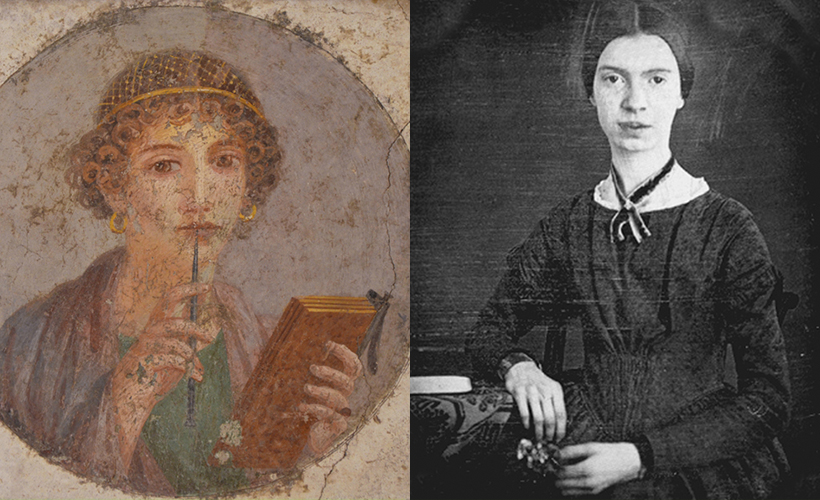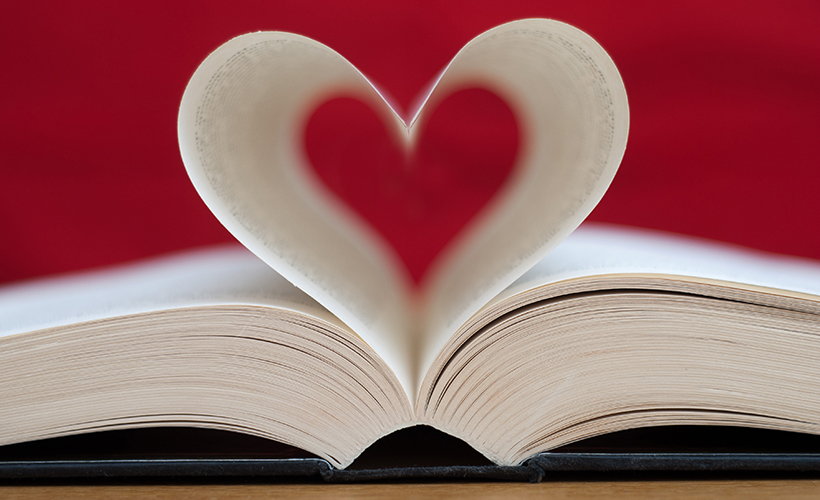Some claim that poetry is useless, to which we at Infobase respond: “Not on Valentine’s Day.” Anyone who’s received a classic love poem in a note—or better, been the subject of an all-new one—knows that poetry is the surest way to get a lover’s full attention. Here at Infobase, we aim to provide our users with practical content to improve their lives in measurable ways. To that end, we hereby provide a collection of the most moving, beautiful, and persuasive love poems from the full-text poetry collection in our Bloom’s Literature database.
Slip one in a Valentine’s card, paste one into an email or text, recite a few lines at a romantic restaurant, or even use them collectively as inspiration for your own creation. You won’t be sorry! We can’t guarantee the sure-fire effectiveness of every poem here, but including one in a Valentine will definitely get you an A for effort, not to mention good taste.
Get Romantic with the Romantics
Let’s start with the great Romantic poets themselves. Scholars of this literary school will tell you that the term “Romantic” refers to an intellectual style obsessed with inspiration and the sublime, rather than romantic love, but poetry devotees know the Romantics wrote some of the finest love poems in the language.
Here’s the second stanza of Percy Bysshe Shelley’s “Love’s Philosophy.” Has there ever been a more perfect way to request a kiss?
See the mountains kiss high heaven
And the waves clasp one another;
No sister-flower would be forgiven
If it disdained its brother;
And the sunlight clasps the earth
And the moonbeams kiss the sea:
What is all this sweet work worth
If thou kiss not me?
If you’re not quite at the kiss-requesting stage, a better move is simply to praise your lover’s beauty. No one did that more memorably than Lord Byron, whose “She Walks in Beauty” begins with this:
She walks in beauty, like the night
Of cloudless climes and starry skies;
And all that’s best of dark and bright
Meet in her aspect and her eyes;
Thus mellowed to that tender light
Which heaven to gaudy day denies.
Sappho and Emily Dickinson

Some lovers are traditionalists, at least when it comes to literature, so when dealing with them, it’s best to go back to the beginning. Perhaps the greatest ancient love poet was the female poet Sappho, whose work exists today only in gorgeous fragments, many of them praising women. But here Sappho describes the overpowering effects of love on her own body:
…the sweat breaks running upon me, fever
Shakes my body, paler I turn than grass is;
I can feel that I have been changed, I feel that
death has come near me.
Try that instead of mumbling about how you get nervous and tongue-tied in someone’s presence.
Sappho’s sexuality is much debated, and many other great poets have managed to keep their romantic lives hidden from history. And good for them. What romances Emily Dickinson had, if any, and with whom, and with what type of person, are unknown to us. During her life she was regarded as a quiet, eccentric spinster. But as we all know, sometimes the quietest people harbor the most fiery passions. Here is the first stanza of Dickinson’s “Wild nights”:
Wild nights! Wild nights!
Were I with thee,
Wild nights should be
Our luxury!
Dickinson’s first editor, Thomas Wentworth Higginson, thought the third stanza of this short poem was too racy for publication. Look it up and decide for yourself.
Love Poetry from the Age of Shakespeare
But for me, the finest love poems of all come from the English 16th and 17th centuries, the age of Shakespeare, of course, but not only him. Has any love poem ever begun more memorably than this?
Drink to me only with thine eyes,
And I will pledge with mine;
Or leave a kiss but in the cup,
And I’ll not look for wine.
That’s from Ben Jonson’s “Song: To Celia.” However, some readers—I’m one of them—prefer the second stanza of the poem, in which the poet describes sending flowers to his lover, suffering the sting of receiving them back again, and cherishing them all the more for having been in her presence:
I sent thee late a rosy wreath,
Not so much honouring thee
As giving it a hope, that there
It could not withered be.
But thou thereon didst only breathe,
And sent’st it back to me;
Since when it grows, and smells, I swear,
Not of itself, but thee.
The greatest poet of all was Shakespeare, and his sonnets, addressed to loved ones both male and female, continue to enchant readers today. But in my opinion, his finest love poetry can be found in his plays. Here is Antony telling his beloved Cleopatra, in the opening scene of Antony and Cleopatra, that they should quit arguing and instead devote themselves to their highest purpose: pleasure.
…for the love of Love and her soft hours,
Let’s not confound the time with conference harsh:
There’s not a minute of our lives should stretch
Without some pleasure now.
Plainspoken Classic Love Poems
Many classic poems are known for their qualities of complex intellectuality, their ability to hold many ideas in a single line. But love poems are best when they’re plainspoken. Here is the end of William Butler Yeats’s “The Song of Wandering Aengus,” on the determination of a lover:
Though I am old with wandering
Through hollow lands and hilly lands,
I will find out where she has gone,
And kiss her lips and take her hands;
And walk among long dappled grass,
And pluck till time and times are done,
The silver apples of the moon,
The golden apples of the sun.
And here is Christina Rossetti piling on not ideas but simple images, in the form of similes, in order to convey the transporting joy of her love:
My heart is like a singing bird
Whose nest is in a watered shoot;
My heart is like an apple-tree
Whose boughs are bent with thickset fruit;
My heart is like a rainbow shell
That paddles in a halcyon sea;
My heart is gladder than all these
Because my love is come to me.
Here is the Harlem Renaissance writer Jean Toomer, simply and beautifully describing a loved one named Cloine in the act of sleeping:
…curled like the sleepy waters where the moon-waves start,
Radiant, resplendently she gleams,
Cloine dreams,
Lips pressed against my heart.
But perhaps the essential quality of poetic lovers is idealism. Life has taught most of us, often too thoroughly, that love in the end usually fails or turns sour. The key is to believe in the moment. In a late-1500s poem often attributed to Sir Walter Raleigh—perhaps directed toward Queen Elizabeth, but who knows?—the poet rejects cynical definitions of love and concludes with this declaration:
…true love is a durable fire,
In the mind ever burning,
Never sick, never old, never dead,
From itself never turning.
And so let us all believe!
The Brownings
Sometimes real-life love does indeed work out the way it’s supposed to. The legendary love affair between Elizabeth Barrett and the much younger Robert Browning resulted in a marriage that was, by all accounts, overflowing with respect and affection. Elizabeth Barrett Browning’s “How do I Love thee?” is perhaps the most famous love poem of all:
How do I love thee? Let me count the ways.
I love thee to the depth and breadth and height
My soul can reach, when feeling out of sight
For the ends of being and ideal grace.
I love thee to the level of every day’s
Most quiet need, by sun and candle-light.
I love thee freely, as men strive for right.
I love thee purely, as they turn from praise.
I love thee with the passion put to use
In my old griefs, and with my childhood’s faith.
I love thee with a love I seemed to lose
With my lost saints. I love thee with the breath,
Smiles, tears, of all my life; and, if God choose,
I shall but love thee better after death.
“Fool, Look in Thy Heart…”
I hope you’ve found something useful among these literary treasures. If not, I leave it to all lovers out there to work on your own creations. No easy task, but there’s only one way through. Sir Philip Sidney begins his sequence Astrophil and Stella with a sonnet on how hard it is to think of a great and convincing love poem. He finds himself, as he puts it, “Biting my truant pen, beating myself for spite.” But his Muse—that is, his inner source of inspiration—gives him a crucial piece of advice:
“Fool,” said my Muse to me, “look in thy heart, and write.”
Go to it.
And here’s the whole poem:
Loving in truth, and fain in verse my love to show,
That she, dear she, might take some pleasure of my pain,
Pleasure might cause her read, reading might make her know,
Knowledge might pity win, and pity grace obtain,
I sought fit words to paint the blackest face of woe,
Studying inventions fine, her wits to entertain,
Oft turning others’ leaves, to see if thence would flow
Some fresh and fruitful showers upon my sunburnt brain.
But words came halting forth, wanting Invention’s stay;
Invention, Nature’s child, fled step-dame Study’s blows;
And others’ feet still seemed but strangers in my way.
Thus great with child to speak, and helpless in my throes,
Biting my truant pen, beating myself for spite:
“Fool!” said my Muse to me, “look in thy heart and write.”
What Is Bloom’s Literature?
The award-winning Bloom’s Literature database is rich with relevant content on the most studied and researched authors and works. Students will find exactly what they need without having to wade through an uncurated search. Educators will appreciate the thoughtful organization and important curriculum tools to help with lesson plans, assignments, and independent study.
See also:
- Celebrate 30 Days of Poetry with Bloom’s Literature
- Read Up on Banned Books with Bloom’s Literature
- Full-Text Short Stories and More Added to Bloom’s Literature
- Learn “How to Write about Literature” with Bloom’s Literature
- Celebrating 95 Years of The Great Gatsby: Why We’ve Added the Full Text of Gatsby to Bloom’s Literature



